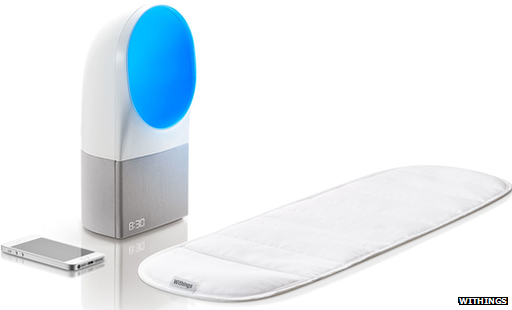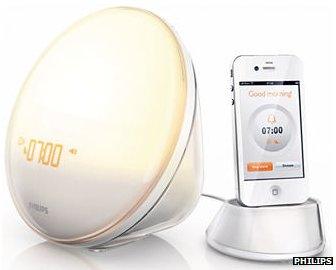CES 2014: Withings sensors promise 'smarter sleep'
- Published

The Aura system adjusts its wake-up timings based on its users' sleep cycles
The maker of a set of communicating bedroom sensors that control a changing-colour lamp claims to be able to wake sleepers at the best moment.
Withings unveiled the Aura "smart sleep" system on the eve of the Consumer Electronics Show in Las Vegas.
One part slides under the mattress to study the dozing owners while another screens their bedroom environment.
It is the first of more than a dozen sleep-related gadgets set to be launched at the event.
However, one expert warned it was too soon to know how much difference such devices could really make to purchasers' health.
Changing light
The Aura system consists of three parts:
A soft padded sensor that is slipped under the mattress. The firm says it is able to record body movements, breathing cycles and heart rates.
A device that should be placed next to the bed. This includes sensors to study noise levels, room temperature and light levels. In addition it contains a clock, a speaker that plays alarm sounds and a circular LED (light-emitting diode) lamp.
A smartphone app that controls the system and provides feedback about the sleepers' night.
The light changes colour from blue to yellow and red across the course of the night on the basis of research that different light wavelengths can affect the secretion of hormones.

Philips' rival Wake-up Light lacks the mattress sensor but can charge a smartphone
Studies have suggested that blue light stimulates melanopsin - a pigment found in cells in the eye's retina, which send nerve impulses to parts of the brain thought to make a person feel alert.
Blue light is also believed to suppress melatonin - a hormone made by the brain's pineal gland which makes a person feel sleepy when its levels rise in their blood.
By switching from blue to red light - via an intermediary yellow or white stage - this process should be reversed, encouraging a feeling of sleepiness.
Space agency Nasa has previously studied the phenomenon and has announced plans to install a light-colour changing system of its own into the International Space Station (ISS) in 2016.
Withings' system is being launched at a cost of $299 (£180).
Philips recently announced a competing product at the same price. Its Wake-up Light system mimics the changing conditions created by a sunrise, turning from red to bright yellow over the course of half-an-hour before sounding an alarm. However, it does not monitor the sleepers themselves.
Early days
Brian Blau, an analyst at the tech consultancy Gartner, said the fall in price of the components involved was encouraging companies to introduce sleep tracking systems, but that consumers should be cautious about the claims made about their benefits.
"Providing data to help you understand your sleep patterns has the potential to help you get over problems with them," he told the BBC.

Sensible Baby will show off a prototype baby sleep monitoring system at CES
"But it's an open question just how useful each individual type of device will be.
"Because they are so new and there's not a mass market yet, I think that a lot of learning and experimentation has got to be done to figure out exactly what to monitor, how best to analyse the data produced and how to give good feedback to whoever is using them."
Other sleep-related technologies on show at CES include:
Sensible Baby - a sensor put in an infant's night clothes that tracks their temperature, orientation and movement. It sounds a smartphone app alarm if it detects a problem.
Sleepow - a pillow that plays tones at slightly different frequencies for each ear, which its maker claims promotes relaxation.
Basis - one of several new smartwatches that can monitor sleep data, in this case by studying the wearer's heart rate, perspiration and skin temperature.
- Published17 December 2012
- Published10 January 2013
- Published2 January 2014